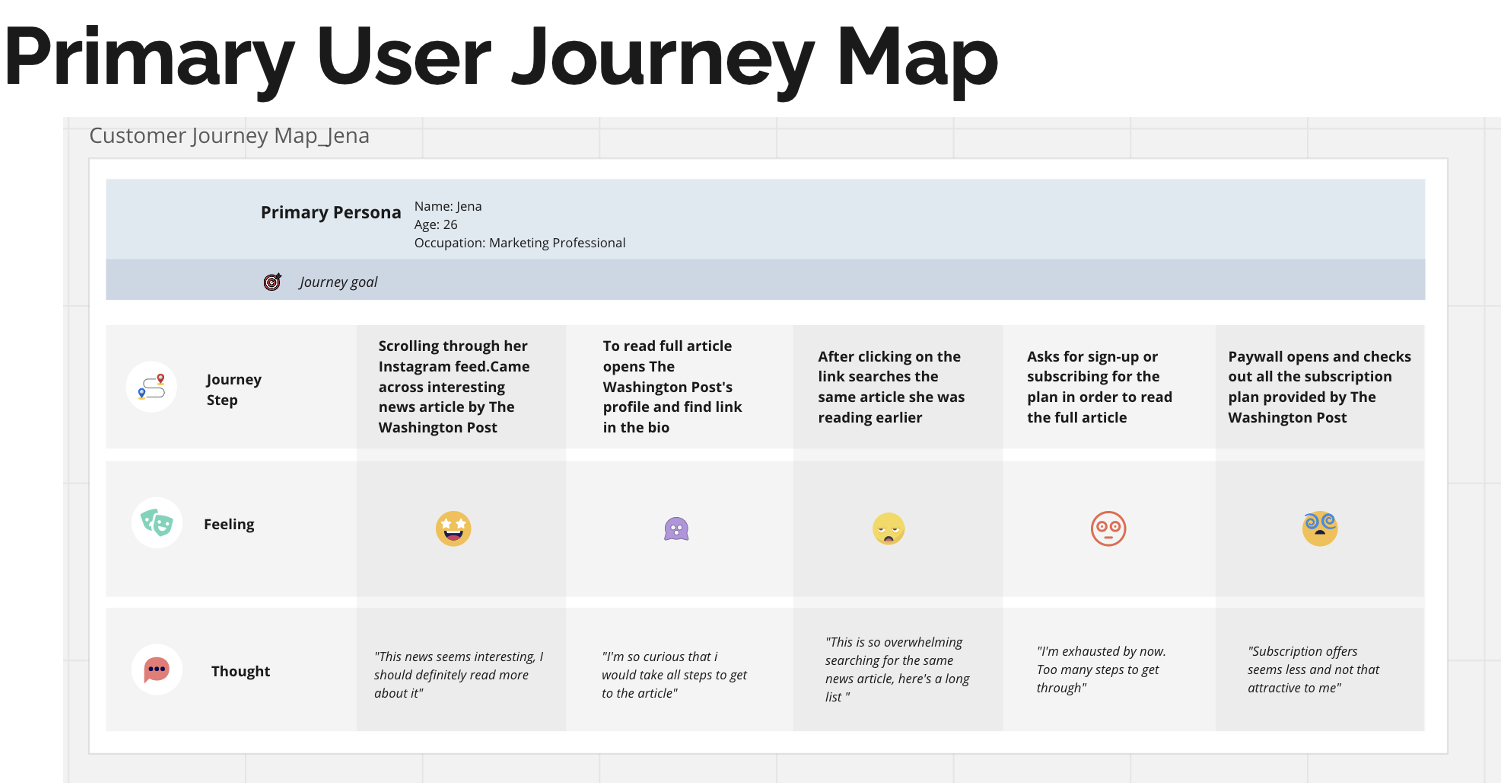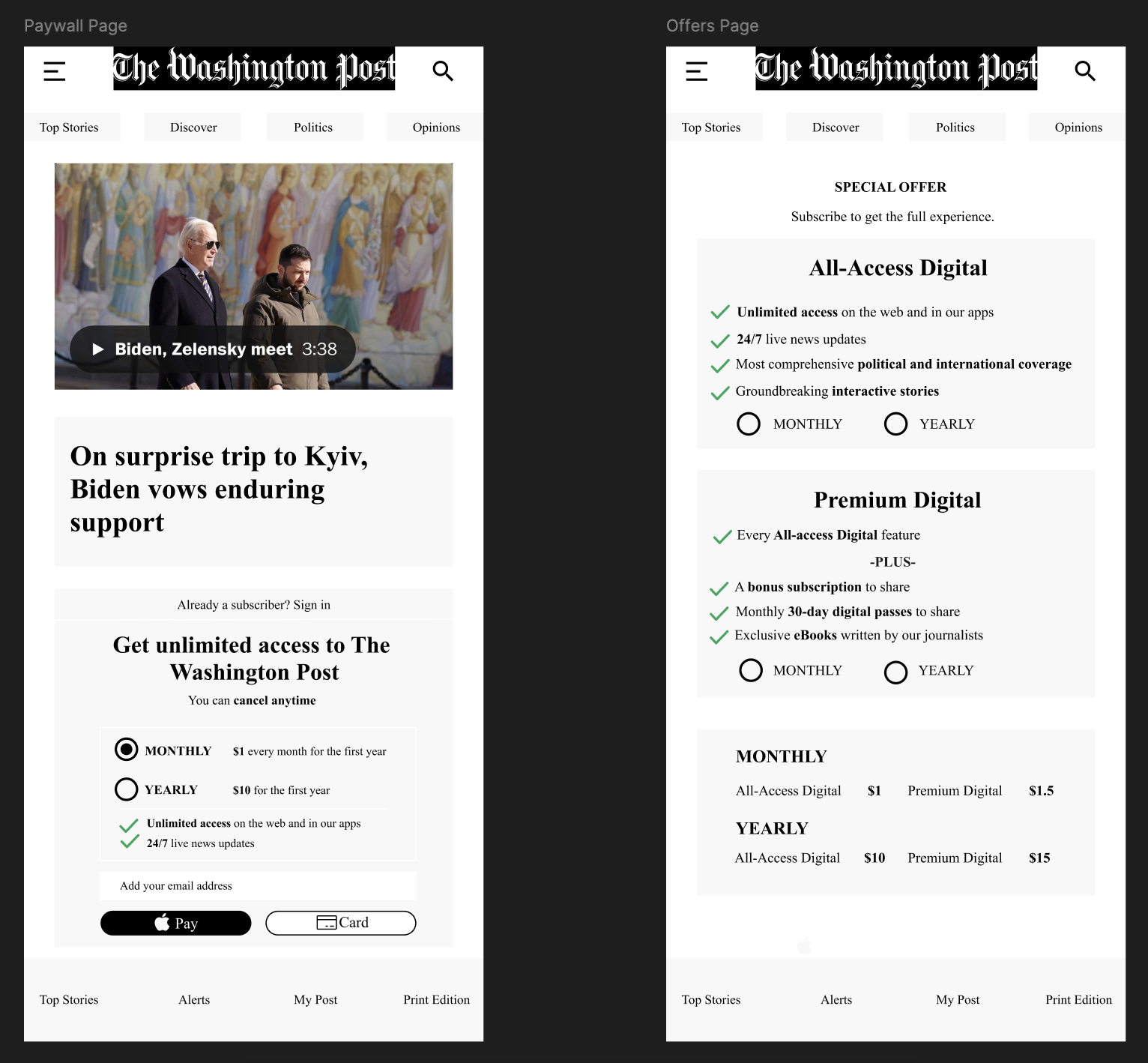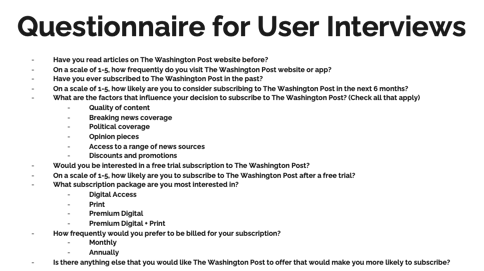The Washington Post
Reimagining Digital Subscriptions
A strategic redesign of subscription offerings to attract and retain younger audiences in an increasingly competitive digital news landscape.
Introduction
The Washington Post is a major American daily newspaper, founded in 1877 and headquartered in Washington, D.C. It's known for its in-depth reporting, investigative journalism, and political coverage.
The publication covers a wide range of topics, including national and international news, politics, business, sports, entertainment, and opinion. In addition to its print edition, it has a robust online presence, with a website that features breaking news, multimedia content, and digital-only features.
Despite its prestigious reputation and high-quality journalism, The Washington Post faces challenges in attracting and retaining younger subscribers in today's digital media landscape.
Role
UX Designer
Focus
Subscription Experience
Methods
User Research, Competitive Analysis, Wireframing
Timeline
3-Week Sprint
Sprint Plan
A structured three-week approach to understand, design, and validate subscription solutions.
Discovery
- Create Sprint plan
- Study The Washington Post and identify the challenge
- Create personas
Research & Ideation
- User Journey Mapping
- Initial sketches
- Questionnaire for user interviews
Design & Validation
- User interviews
- Mid-fidelity wireframes
- Prepare presentation
Identifying the Challenge
A comprehensive approach to understanding The Washington Post's subscription challenges.
Research Process
- Business & User Understanding
Researched The Washington Post's history, business model, and target audience - Website Walkthrough
Conducted a comprehensive analysis of the current website and subscription flow - Social Media Analysis
Browsed social media accounts of The Washington Post on Instagram, TikTok, and YouTube - Competitive Analysis
Compared with The New York Times on UX, subscription plans, and social media strategy
Research Methodology
The Challenge
- Declining subscription numbers across all demographics
- Particularly low engagement and subscription rates among young and Gen Z users
- Current subscription plans perceived as unattractive and not value-oriented
The Solution
- Conduct user interviews to understand young users' needs and preferences
- Redesign subscription plans to be more attractive to young users based on their feedback
- Create a more engaging and value-driven subscription experience
Competitive Analysis
A detailed comparison with The New York Times to identify opportunities for improvement.
| Feature | The Washington Post | The New York Times |
|---|---|---|
| Subscription Pricing | Limited options, higher entry price point | More flexible options, student discounts |
| Free Article Access | Limited free articles per month | More generous free article allowance |
| Social Media Engagement | Less engagement with younger audiences | More active on platforms popular with Gen Z |
| Mobile Experience | Good but room for improvement | More refined, better personalization |
| Subscription Benefits | Standard digital access benefits | Additional perks like Games, Cooking, etc. |
User Personas
Understanding the target users and their needs to inform our design decisions.
Primary Persona
Young Professional, 25-34
Primary persona details would be displayed here
Goals
- • Stay informed on current events
- • Access quality journalism
- • Flexible subscription options
Pain Points
- • High subscription costs
- • Limited free article access
- • Lack of personalization
Secondary Persona
College Student, 18-24
Secondary persona details would be displayed here
Goals
- • Access for academic research
- • Affordable pricing options
- • Mobile-friendly experience
Pain Points
- • High subscription costs
- • Limited free article access
- • Lack of personalization
User Journey Mapping
I mapped the primary user journey to understand the pain points and emotional states users experience when trying to access Washington Post content.

User journey map revealing key friction points in the subscription flow, from content discovery to paywall encounter
Key Pain Points Identified
- Overwhelming search process after clicking from social media
- Too many steps required to access desired content
- Subscription plans appear unattractive and confusing
- User exhaustion leads to abandonment before conversion
Emotional Journey
Design Solution
Based on user research insights and journey mapping findings, I redesigned the subscription experience to address key pain points and improve conversion.
Before & After: Subscription Flow Redesign

Left: Current paywall experience with limited information. Right: Redesigned offers page with clear value proposition and structured pricing tiers.
Problems with Current Design
- Limited subscription options with unclear value proposition
- Minimal feature descriptions don't justify the cost
- Pricing structure appears confusing and temporary
- No clear differentiation between subscription tiers
Redesign Improvements
- Clear tier structure with "All-Access Digital" and "Premium Digital" options
- Comprehensive feature lists with checkmarks for easy scanning
- Transparent pricing with monthly and yearly options clearly displayed
- Enhanced value communication through detailed benefit descriptions
Design Rationale
The redesigned subscription page directly addresses the pain points identified in the user journey mapping, particularly the confusion and lack of perceived value that led to user abandonment.
Clear Value Proposition
Detailed feature lists help users understand what they're getting for their money
Structured Options
Two clear tiers make decision-making easier and reduce cognitive load
Transparent Pricing
Clear monthly and yearly pricing builds trust and reduces confusion
User Research Methodology
After creating the wireframe designs, I conducted structured interviews with potential subscribers to validate the design decisions and gather feedback on the proposed subscription experience.
Interview Questionnaire
I developed a structured questionnaire to test the wireframe designs and validate our design assumptions. The questions were designed to gather feedback on the proposed subscription experience and understand user preferences for the new design.
Covering usage patterns, subscription history, and preferences
Target demographic aged 18-35 from diverse backgrounds
Usage patterns, decision factors, and subscription preferences

Structured questionnaire designed to gather insights on user preferences, behaviors, and subscription motivations
Usage Patterns
Understanding how frequently users visit The Washington Post and their reading habits
Decision Factors
Identifying what influences users' subscription decisions, from content quality to pricing
Preferences
Learning about preferred subscription packages, billing frequency, and desired features
Key Takeaways
The user interviews revealed valuable insights about subscription behaviors, preferences, and decision-making factors among our target demographic.
Usage Patterns & Behavior
Subscription Preferences
Key Decision Factors
Billing Preferences
Critical Insight
While all participants had engaged with Washington Post content, price sensitivity and lack of perceived value were the primary barriers to subscription. The research validated our hypothesis that clearer value proposition and flexible pricing options are essential for converting younger audiences.